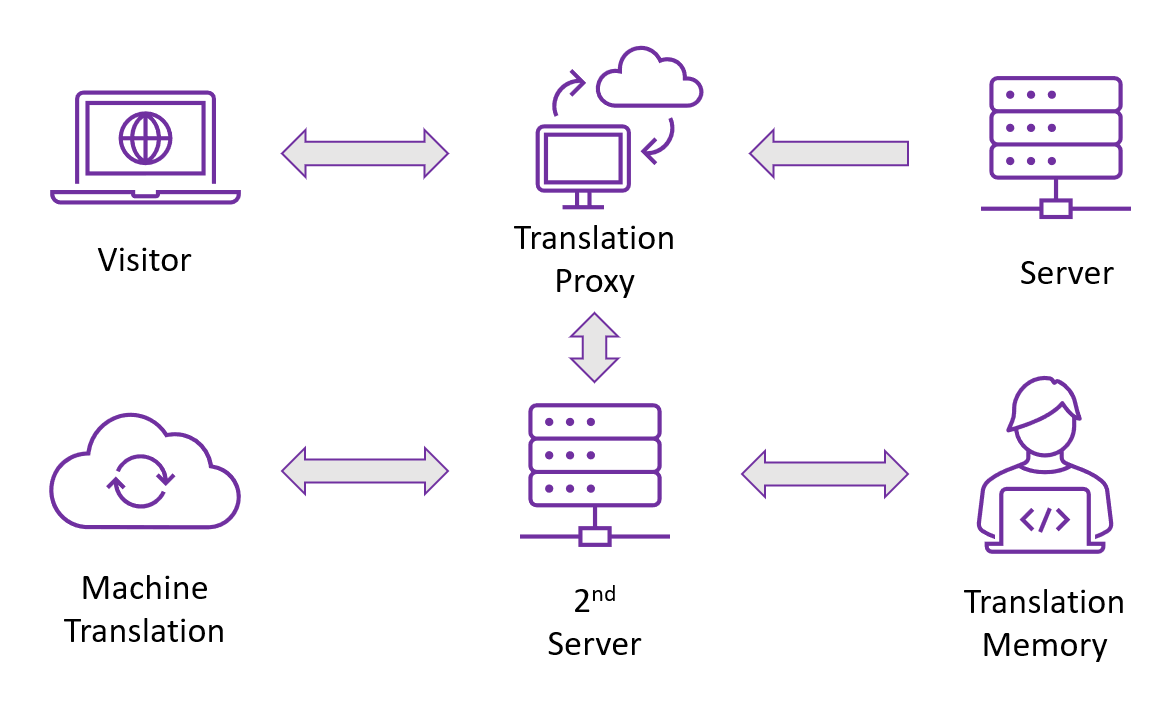
Last week in Max's class, I learned about proxy translation from a practical perspective — mainly how to use tools that are already existed to localize websites quickly (Weglot, Easyling...). While the hands-on experience was helpful, I'm more curious about how the technology actually works behind the scenes. So I decided to dive deeper into the underlying mechanism and found that once you connect the concept with JavaScript, it becomes surprisingly interesting. This blog serves as an attempt to document and share that exploration.
When we talk about proxy translation, we're describing a smart middleware layer that sits between your web server and global users. Instead of embedding translations directly into your CMS or codebase, a proxy server intercepts every request and dynamically serves localized versions of the page. You can think of it as a live multilingual filter that overlays your site in real time.
This approach is especially popular among organizations that need to go global quickly without modifying their source code or maintaining multiple repositories. Moreover, proxy-based localization solutions are definately a game changer for non-profits or smaller teams that do not havbe dedicated localization engineering support and resource. Because the translation layer sits externally, there's no need to touch the site's source code or juggle mjultiple repos. Everthing runs throught the proxy, which means real-time updates, any change made on the original site automatically syncs across differant localized versions.
Let's explore how this process works in practice and how JavaScript drives the logic behind it.
1. The Big Picture: From DOM Crawling to Multilingual Delivery
At the core of a translation proxy is a web crawler (or spider) that scans your website and extracts all user-facing strings from the DOM (Document Object Model). If you've ever written JavaScript like this:
const elements = document.querySelectorAll("*");
elements.forEach(el => {
if (el.childNodes.length && el.innerText.trim() !== "") {
console.log(el.innerText);
}
});
you've already simulated the basic behavior of a proxy spider.
The code traverses the DOM tree, collects visible strings, and prepares them for translation.
In a real proxy setup, these strings are stored in a multilingual string database. Each entry corresponds to a translatable segment on the page. When your content changes, the crawler runs again and compares new DOM text with the database. New strings are added, updated ones are flagged, and deleted ones are archived. It works almost like version control, but for text.
2. How JavaScript Powers this Layer
When a localized page is requested, a lightweight JavaScript module on the client side performs real-time replacements. This module functions as a DOM rewriter, injecting the translated strings into the right locations. Heres a simplified example:
window.addEventListener("DOMContentLoaded", () => {
const lang = navigator.language || 'en';
fetch(`/proxy/api/strings?lang=${lang}`)
.then(res => res.json())
.then(translations => {
Object.entries(translations).forEach(([key, value]) => {
const node = document.querySelector(`[data-i18n="${key}"]`);
if (node) node.textContent = value;
});
});
});
This script follows the same principles used by most proxy-based localization tools.
It fetches the translated strings for the active locale, locates the matching DOM elements using unique identifiers (like data-i18n), and replaces the source text dynamically.
3. Monitoring Changes and Managing Translation Workflows
The proxy server doesn't just serve translations. It also monitors your site for updates. When new strings appear, the proxy flags them as "added" or "modified" and automatically triggers a TMS project.
For example, when a new call-to-action button appears on the site:
{
id: "cta_buy_now",
source: "Buy Now",
target_fr: "Acheter maintenant",
updated: true
}
the proxy identifies that updated is true, sends the segment to the TMS, and waits for translation. Once the translator (or MT engine) finishes the task, the translated string is synced back to the database. The next time a French user visits the page, the JavaScript module immediately replaces "Buy Now" with "Acheter maintenant."
This automation creates a continuous localization workflow with almost zero manual intervention. There's no need to upload files or redeploy your website; the system handles updates in real time.

4. Going Beyond Text: Adapting Images and Layouts
A good proxy system can also handle image localization. Some visuals contain embedded text or may not be culturally appropriate for every audience. In those cases, the JavaScript layer can conditionally replace image assets. For instance:
const img = document.querySelector("#hero-banner");
if (userLang === "ja") img.src = "/assets/jp/fingerstyle_guitar.png";
This small piece of logic ensures that users in Japan see the localized version of your fingerstyle guitar banner. It's a subtle but powerful way to make marketing content feel authentic in every locale.
5. Why Engineers Like Proxy Translation
From an engineering perspective, proxy translation is appealing because it simplifies localization workflows without breaking existing infrastructure. It is:
- Non-intrusive: You don’t need to alter your source code or CMS structure.
- Scalable: The system automatically detects and updates translatable content.
- Real-time: Translations appear instantly after being synced.
- Debuggable: Engineers can inspect translated nodes directly in browser DevTools.
For companies without dedicated localization engineers, this approach provides a balance between automation, flexibility, and reliability.
Wrapping Up
Proxy-based localization might look complex from the outside, but at its core, it's a clean integration of web crawling, database synchronization, and DOM manipulation. JavaScript is the glue that makes it all work, connecting the front-end display with real-time translation data.
Next time you visit a website that instantly switches languages, remember that behind the scenes, a crawler is mapping its DOM, a database is tracking every string, and a JavaScript module is updating the text in milliseconds while your original website remains untouched.







